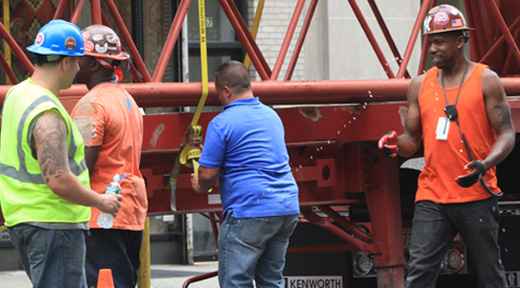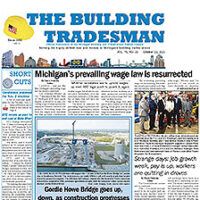
DETROIT (PAI) — Some arguments can best be won with the opportune use of a good example.
Here’s one: Which is safer, construction projects with a union or nonunion workforce? You might have your own opinion on that subject — government statistics on safety, injury and fatality are rarely broken down according to union affiliation.
So along comes this example that — in a backdoor manner — provides a powerful character witness for the safety practices of union workers and their contractors.
On May 9, the Associated General Contractors of America sent out a news release that five of the nation’s largest construction trade associations teamed up to form the Construction Coalition for a Drug- and Alcohol-Free Workplace.
The coalition has a painfully useless acronym (CCDAFW) and as it turns out, pain-free requirements for member contractors to give little more than lip service to a safer workplace. The group is comprised of the anti-union Associated Builders and Contractors (ABC), the Associated General Contractors, the Construction Industry Round Table (CIRT), Construction Users’ Roundtable and Women Construction Owners & Executives.
The coalition’s mission is “to create a drug- and alcohol-free construction industry by providing companies and organizations with the resources necessary to implement drug- and alcohol-free policies into their business practices.”
Sounds impressive. But practically speaking, how they gonna do that? We’re imagining a nationwide database of construction workers who have a card that can be swiped at any jobsite to show they’re ready to meet an employer’s conditions for working on their property. The reality: not even close.
Instead, the group decided on the following “news” as part of that press release: “CCDAFW today launched a nationwide effort urging construction-related firms and organizations to sign an online pledge signifying they will create and maintain a workplace free from substance abuse. In addition to listing current pledge signatories, the CCDAFW website, www.drugfreeconstruction.org includes educational materials and state-by-state policies for substance abuse testing.”
Be still, our beating hearts: An online pledge! Educational materials! Easy to find state-by-state policies!
We looked for more meat on the bone. All we found were quotes that said next-to-nothing. “We are driving an industry toward world-class safety,” said ABC President and CEO Michael Bellaman. And this from CIRT President Mark Casso: “As an organization composed of CEOs from both leading design and construction firms, the CIRT Board of Directors the center piece of this effort as not only the pledge itself, but also the educational materials, model policies, informational aids and best practices that will be made available and shared.”
Now, compare those ridiculously empty words with what the union construction sector has been doing in Michigan since 1987 when MUST (Management and Unions Serving Together) was started.
MUST was formed following an expressed desire from employers to develop a standardized method of testing construction workers for drugs and alcohol. Standardized safety training modules came later. It wasn’t a smooth process, but unions eventually saw they could provide added value to employers and owners who recognized the promotion of on-the-job safety as both a moral duty and economic benefit.
Last year alone MUST administered 25,167 drug tests, and 127,649 safety tests. That’s a little more than sponsoring an online petition.
And there’s more. The Boilermakers have their own nationwide MOST safety program. Do a Google search on building trades drug and alcohol testing and you will find scores of hits on local and regional union programs nationwide. Union apprentice-ship schools spend millions of dollars on safety training. At the very least, numerous union health and welfare plans offer drug and alcohol counseling as part of benefits to workers.
“We had to overcome a lot of resistance as the MUST program was being set up,” said Patrick Devlin, Secretary-Treasurer of the Michigan Building and Construction Trades Council. “It’s a lot easier to talk than it is to take action when it comes to drug and alcohol testing and safety training.
“You’re not going to see this kind of program much on the nonunion side because it’s expensive. The bottom line is that nonunion employers take online pledges to improve safety. Union members and employers actively work together to improve safety.”
Marty Mulcahy is managing editor of The Building Tradesman
Photo: Construction workers squirt water on each other to cool off while disassembling a crane in blistering heat. Mary Altaffer/AP












Comments